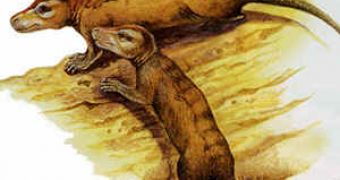Mammals are supposed to have bloomed after the disappearance of the dinosaur, 65 million-year ago. During the dinosaur times, all mammals must have been shrew-like creatures hiding during the day and only getting out in the night to hunt for insects.
But a fossil jawbone of Teinolophos, an 122 million-year old fossil from southeastern Australia, shows that in the middle of the dinosaur era, platypuses already existed, and they are specialized mammals, with duckbills and complex adaptations to water life. New researches continue to show that, during the dinosaur time, mammals were complex and many complex traits have evolved independently in different groups.
When we talk about flight, mammals can laugh at birds. Because the first flying mammals took off at the same time with birds' emergence, or perhaps earlier, during the Dinosaur Era, and more than 70 million years before the first known bat.
A furry squirrel-sized mammal found in Inner Mongolia (China) provided with clues that mammals were gliding in ancient forests at least 125 to 165 millions years ago, surpassing the earliest known flying bird, Archaeopteryx, dated about 150 million years ago. Volaticotherium antiquus-"ancient gliding beast", was so unusual that was classified into a new order of mammals. The little glider was so well preserved that scientists could clearly identify the skin membrane (patagium) that stretched between its fore and hind limbs, a direct evidence that it was adapted for gliding flight. The remains also retained impressions of the fur covering its body. The creature's sharp teeth revealed an insect-eater, like most mammals of its time, and unlike the modern day gliders. This fossil provides a "dramatically new picture" of the diversity of the mammals that lived in the age of the dinosaurs.
Mammalian middle ear bones and molars are specific and easier to follow in the fossils. Now some paleontologists point they may have emerged several times within the mammals. Maybe placenta or marsupial pouch evolved just once, but other traits seem not to have done it. This is revealed by fossils dug in the last decade in the Southern Hemisphere, in Antarctica and Australia.
Before, the earliest placental mammals (humans and most living mammal species) and marsupial mammals had been found in Northern Hemisphere, in the Cretaceous period (about 150 million-year ago). These are the only mammals known to give birth to living young, thus the researchers pointed they split from a common ancestor on the northern supercontinent Laurasia (joining Asia, Europe and North America). Subsequently, they headed south.
But, in1997, researchers discovered, in southeastern Australia, an 120-million-year-old jawbone belonging to the mammalian species, Ausktribosphenos nyktos, which appeared to be an early placental. Such a finding challenged the Laurasian hypothesis, and showed somehow that marsupials had prevailed over placental in Australia (unlike in the rest of the world).
The debate was triggered by the massive molar of Ausktribosphenos, differentiating marsupials and placentals from other fossil mammal groups, which 120 million years ago did not have molars, but pointed teeth, like in crocodiles. Instead, Ausktribosphenos had modern crushing molars, like us. It was too early.
Subsequently, three pointed teeth soldered in a triangular pattern, resulting thicker teeth called tribosphenic molars, which could crush and grind, enabling a diversification of the diet. And Ausktribosphenos had this advanced molar.
Later researches looking for the place of Ausktribosphenos in the mammalian family tree revealed that the tribosphenic molar evolved at least twice independently in Ausktribosphenos and other Southern fossils along with the monotremes (egg-laying platypus and spiny anteaters) and in the Northern Hemisphere in placentals and marsupials. Thus, Ausktribosphenos was not a placental at all.
Even the middle ear, a hallmark of all true mammals, could have evolved several times. In mammals, the middle ear is made of three tiny bones connected to the skull through the eardrum. Two of the bones evolved from those of the reptilian lower jaw. A series of fossils showed the path from reptiles toward mammals.
Rear bones of the reptilian jaw can transmit sound; in mammal-like reptiles, these bones turned smaller and gradually migrated to the ear area. In time, the bones turned loose, then free from the jaw, entering the middle ear.
Teinolophos, the platypus of the dinosaurs' time, had an ear very similar to that of cynodonts, the reptilian ancestors of the mammals, with incompletely shaped middle ear bones, still attached to the jawbone. This means that the earliest true mammals did have bones fully disconnected from the jaw, and the middle ear bones of the modern monotremes, on one side, and marsupials and mammals, on the other side, appeared independently.
A 2008 Chinese research found a slim bit of cartilage fixing the middle ear bones to the jaw in an 125 to 122 million-year-old primitive mammal from China, Yanoconodon. Embryos in some living mammals have a similar transitory stage. It appears that the separation operated several times.

 14 DAY TRIAL //
14 DAY TRIAL //